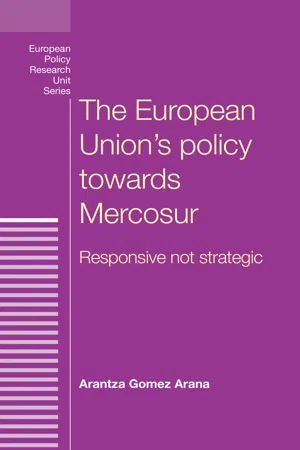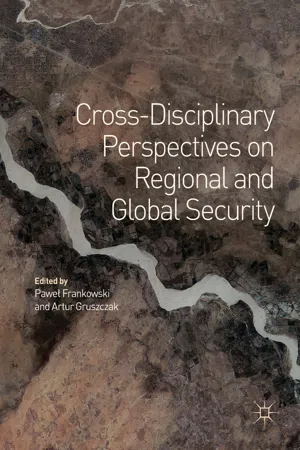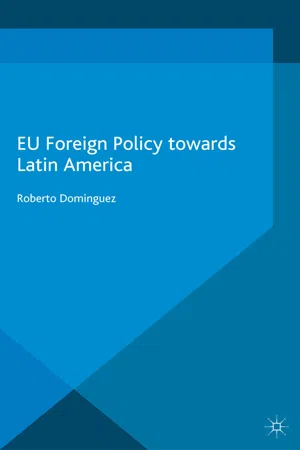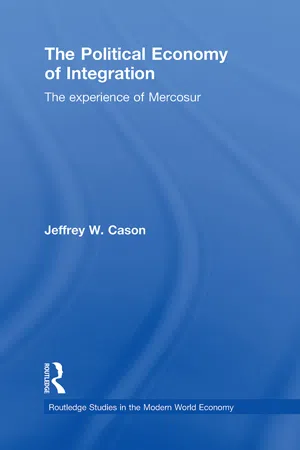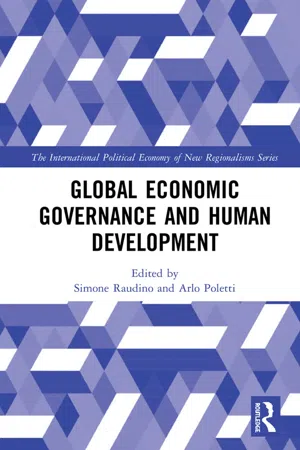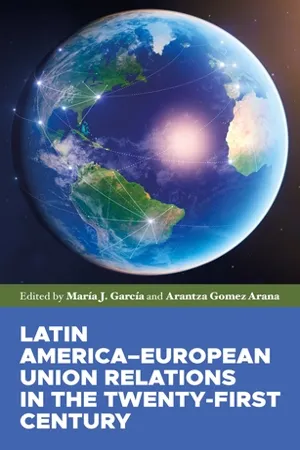Geography
Mercosur
Mercosur is a South American trade bloc established in 1991 to promote economic integration and cooperation among its member countries. Its primary goals include the elimination of trade barriers and the facilitation of economic development within the region. Mercosur's member countries include Argentina, Brazil, Paraguay, and Uruguay, with additional associate members and observer countries.
Written by Perlego with AI-assistance
Related key terms
Related key terms
1 of 4
Related key terms
1 of 3
9 Key excerpts on "Mercosur"
- eBook - ePub
The European Union's policy towards Mercosur
Responsive not strategic
- Arantza Gomez Arana(Author)
- 2017(Publication Date)
- Manchester University Press(Publisher)
1992 ), for example. The Cold War and the fear of Latin American countries following Cuba's example, after Castro led the revolution in 1959 and made it into a communist state, gave the US the perfect excuse for adopting an even more interventionist approach. This is somewhat evident in the case of the 1980s Central American crisis. At that point the EU intervened in the region for the first time, opening the door to different types of relationships between Europe and Latin America, among them EU–Mercosur relations.An introduction to Mercosur: the golden boy of regionalism in Latin America
There have been many attempts to develop regional groups in Latin America: for example, the Organization of Central American States in 1951, the Latin American Free Trade Association in 1960 and the Andean Pact in 1969. However, none of these groups was ever able to achieve the same degree of integration as Mercosur. Mercosur has been considered to be not only the most integrated regional group in Latin America, but also one of the most integrated regional groups in the world after the EU. This section will begin by introducing each of the countries that are members of the Mercosur, followed by an explanation of the Mercosur institutions which are central to the discussion and analysis offered in this case study.Mercosur countries
Brazil
Brazil is by far the largest of all Mercosur countries, covering roughly 75% of the Mercosur geographical territory. Due to both its colonial past and the way that it gained independence from Portugal, Brazil's socio-economic profile can be described as a system of oligarchies. This system has had a direct impact on the question of land distribution/re-distribution, which in turn has had both a continuous and direct impact upon the Brazilian political landscape. In the area of politics, there have been a series of shifts from democratic to dictatorial governments over time. In very broad terms, one period could be seen as running from 1930 to 1964, an era characterized at the outset by a quasi-democratic government, but due to economic instability the country started to experience social turmoil in the late 1940s. Skidmore (1967 ) provides a comprehensive discussion of Brazilian politics during this period. Skidmore also outlines the nature of the US's involvement in the coup d’état - eBook - ePub
The Reconfiguration of Twenty-first Century Latin American Regionalism
Actors, Processes, Contradictions and Prospects
- Rowan Lubbock, Ernesto Vivares(Authors)
- 2022(Publication Date)
- Routledge(Publisher)
The challenges of economic integration in Latin America: searching for consensus in contexts of globalization. The case of Mercosur (1991–2019)
Mercedes Botto IDABSTRACT
This paper analyses the trajectory of Mercosur from a critical historical perspective. This interpretation presents an alternative to more Eurocentric approaches to regionalism, which tends to view Mercosur as a failed integration process due to the inability of governments to build supranational institutions in the image of the European Union. In contrast, I analyse Mercosur as a field of contestation between visions of autonomy or dependence. Consensus between national actors with different visions, material capacities and institutions varied over time with direct effects on the correlation of political forces. However, the results of this dispute remain strongly tied to the international division of labour. To demonstrate this idea, this article moves through three stages of Mercosur, identifying the changes in terms of consensus and dissent between national governments around the regional institutional framework and its external realignment.1. Introduction
Latin American regionalism emerges from a political project spanning all the way back to the early nineteenth century as an outcome of the struggle from independence. In the 1960s this idea reappeared economically, promoting the integration of expanded markets with high tariff barriers with respect to third countries, and strengthening trade in industrial manufactures produced in the region. In this way, economic regionalism echoed the idea that, through equal cooperation, it was possible to break the situation of dependence that bound Latin American economics with the fate of developing countries more generally (Prébisch, 1963 ; cf. Sunkel, 1995 ).Mercosur takes up this integrationist aspiration, but it does so in an international and regional context very different from the previous one. The end of the Cold War and the great technological advances of the late 1980s fuelled the expectation that economic globalization would bring benefits for all. Accompanying this expectation was the creation of new modes of economic interdependence, deregulation, new global governance institutions (such as the World Trade Organisation), and proliferation of Regional Integration Agreements (Bergsten, 1997 ; Stallings, 1995 ). Rather than promoting states’ freedom of action, as had occurred with protected or closed integration, open regionalism carves out new spaces of accumulation for the benefit of transnational capital seeking investment markets and flexible terms of production and export (Cox & Sinclair, 1996 ; Robinson, 2008 - Paweł Frankowski, Artur Gruszczak, Pawe? Frankowski, Artur Gruszczak, Pawe? Frankowski, Pawe? Frankowski(Authors)
- 2018(Publication Date)
- Palgrave Macmillan(Publisher)
Two main concerns drove economic integration in Mercosur: improving domestic economic development and interdependence, on the one hand, and boosting the region’s economic position in the global economy on the other hand. As part of the first rationale, Mercosur was a means for Argentina and Brazil to trade freely within and outside of South America, locking in the principles of the Washington consensus: deregulation, liberalization and privatization (Meissner 2017, p. 152). Economic development was seen as crucial for the region and its stability (Oelsner 2009). As part of the second rationale, which was much more important to the region due to its dependence on extra-regional trade (Meissner 2017), Argentina and especially Brazil feared marginalization in the global economy, which was increasingly characterized by globalization and global value chains (Buzan and Waever 2003, p. 325). Brazil repeatedly emphasized that Mercosur boosts the region’s and its own country’s global visibility, making the region more attractive to foreign investors and trade partners (Meissner 2017)—such extra-regional economic relations were and are still vital for South America. Therefore Mercosur’s member states set up the customs union in 1994 which was supposed to lock in liberal reforms, attract investments and trade partners as well as improve the region’s visibility and bargaining power on the international stage. A second set of security ideas, next to economic concerns, revolved around domestic and transnational security in South America. These domestic and transnational threats subsume a large set of security aspects, including consolidation of democracy, the fight against corruption, trafficking of drugs, persons and weapons, terrorism as well as transnational organized crime (Oelsner 2011 ; Weiffen et al. 2013, p. 378 f.). Focusing on democratic stability, this was a crucial factor in the integration dynamics of Mercosur- eBook - ePub
South American Free Trade Area or Free Trade Area of the Americas?
Open Regionalism and the Future of Regional Economic Integration in South America
- Mario Carranza(Author)
- 2017(Publication Date)
- Routledge(Publisher)
Regional Blocs: Building Blocks or Stumbling Blocks? London, Macmillan Press, Table 6.4, p. 148. Reproduced by permission of Macmillan Press Ltd.,Basingstoke, Hampshire, UK. © A. S. Bhalla and P. Bhalla 1997.Because of Brazilian objections, Mercosur's common external tariff (CET) was only nominally close to the "ideal" CET recommended by neoliberal economists. For example, Sebastian Edwards echoed Yeats's attack on Mercosur when he wrote that "for the case of Argentina, joining a trade agreement with a Brazilian-level common external tariff is likely to result in significant 'trade diversion' that would more than offset any benefits derived from trade creation."46 Although Brazil made concessions on the CET agreed upon at Ouro Preto, the list of temporary exceptions was important; the CET was set at 11 different levels, from 0 to 20 percent. Each country was allowed to exempt 300 items (399 for Paraguay) and the final "convergence" CETs for imported capital goods (14 percent by 2001) and telecommunications equipment (16 percent by 2006) were higher than the "ideal" CET recommended by Edwards (Argentina's average tariff of 10 percent, because it was the least protectionist). Hence, one may argue that there has been moderate trade diversion for the two largest Mercosur partners, more for Brazil than for Argentina, considering the higher level of protection of its domestic industry.475. Mercosur as an International Actor: Relations with Other Latin American Countries, NAFTA, and the European Union
Despite the rhetoric of openness, Mercosur was conceived from the beginning as an instrument to increase the Southern Cone countries' bargaining power vis-à-vis northern regional economic biocs in the post-Cold War international environment.48After becoming an imperfect customs union in 1995, Mercosur began projecting itself as an important actor in the world stage. The first step was the widening of Mercosur to reach other South American countries. Mercosur plays an essential role in intra-Latin American trade relations: - eBook - ePub
- R. Dominguez(Author)
- 2015(Publication Date)
- Palgrave Macmillan(Publisher)
1From a trade perspective in South America, another contribution of Mercosur is that its enlargement indicates its strength as a new gravitational force in the region. Mercosur has enlarged to include Venezuela2 as a member, developed associate memberships with Chile, Bolivia, Colombia, Ecuador, and Peru,3 and also started to review the application of Bolivia as a full member. However, there is also a risk that the Venezuelan, and potentially Bolivian accession may bring internal divisions due to the differences in the free trade strategies and philosophies among the Mercosur members (Klonsky et al. 2012).Mercosur is facing multiple challenges. Gomez Mera (2013) explains that Mercosur is marked by the instability and recurrent conflict between Argentina and Brazil and Malamud (2005) adds that the underlying formula of Mercosur is reaching preferential access to the Brazilian market in exchange for Argentine support for Brazilian international trade strategies. However, ‘as time went by, both countries stepped back from their mutual understanding, giving way to increasing suspicion and decreasing cooperation’ (Malamud 2005: 426). Pena and Rozemberg (2005) have also identified several obstacles to the implementation of Mercosur. For example, a common external tariff (CET) has faced barriers to be fully implemented due to a long list of exceptions for sensitive products, such as motor vehicles and sugar (Doctor 2013). From the institutional perspective, some of the problems are based on the desire to maintain national control over the integration process as underlined by the poor implementation of Mercosur decisions and norms into domestic law (Schelhase 2011). Malamud (2008) indicates that in 2005–2006 half of Mercosur regulations that require transposition were not in force and more than half of Mercosur norms also contained confidential annexes, which paved the way for a national veto opportunity or an obstacle for practical implementation of Mercosur’s agreements (Hummel and Lohaus 2012). - eBook - ePub
The Political Economy of Integration
The Experience of Mercosur
- Jeffrey W. Cason(Author)
- 2010(Publication Date)
- Routledge(Publisher)
Finally, the debt crisis, which had wracked the Latin American economies for most of the previous decade, was dissipating, particularly in reaction to the Brady Plan (Roett 1992). Foreign capital—both as foreign direct investment and portfolio investment—was at last returning to the region. This meant that quite suddenly Latin American countries would no longer have to deal with constant balance-of-payments crises that the debt crisis had engendered. Therefore, there was a greater freedom of maneuver for a number of Latin American nations, and proactive policy was possible.And so, Brazil and Argentina, along with Uruguay and Paraguay, established Mercosur in 1991. This chapter will tell that story, from a variety of angles. The first section focuses on the changing international context facing the Mercosur countries when they embarked on integration, and how this changing context influenced the integration process. The second section considers in detail the changes in political leadership that occurred with the elections of 1989 in Argentina and Brazil. It will also delve into the different interests of state, business, and labor actors when this integration experiment first emerged, detailing their different visions and different political strategies.The third section of this chapter outlines the main thrust of the Treaty of Asunción, which established Mercosur. Here, I will focus on the key points of agreement and disagreement and the outlines of the Treaty itself and the way in which it committed the Mercosur nations to a new process of integration. The fourth section looks at the issue that caused most consternation in the Mercosur process in its early years: the problematic nature of economic stabilization in Argentina and Brazil. Both nations had suffered, under previous regimes, from chronic high inflation, which had led to hyperinflation at certain points. Indeed, it is quite remarkable that the Mercosur nations even agreed to integrate at this particular point in time, given domestic economic and political instability. It is probably safe to say that European nations would never have agreed to integrate under the sort of instability that the Mercosur nations experienced. Nevertheless, they achieved this unlikely prospect, and this section will explain how this happened. As noted in previous chapters, there were clear limitations to this integration process, which made it quite unlikely to follow a European pattern. In part, this limitation comes out of the fact that at its beginning, it was meant to address only commercial issues. In fact, the presidents that pushed it at the outset wanted to increase trade with the entire world, and not just Mercosur’s neighbors. They were skeptical of industrial policy and state intervention, and saw Mercosur as a springboard for much greater economic openness. As the integration project developed, the decisions associated with this initial impulse would cast a long shadow over what integration could become. - eBook - ePub
- Simone Raudino, Arlo Poletti(Authors)
- 2018(Publication Date)
- Routledge(Publisher)
As a result of these domestic political dynamics, both Brazil and Argentina had already adopted an impressive amount of pro-market reforms before the birth of Mercosur. In this context, Mercosur was seen as a powerful tool to both deepen and accelerate the ongoing neoliberal transformation of these economies (Manzetti 1993). Therefore, far away from being a mere external imposition on South American governments, Mercosur should be interpreted as the result of two convergent agendas, “from within” and “from without” the continent: Mercosur was the result of broader changes at the international level and of the neo-liberal policies of Presidents Menem of Argentina and Collor of Brazil (Gardini 2007). 19 By virtue of provisions contained in the Mercosur agreement, the degree of openness of member countries rose sharply. The new international trade regulations implied the convergence to a binding common external tariff vis-à-vis the rest of the world’s goods and services, as well as the liberalization of intra-member trade, despite the reluctance of both the primary and secondary sectors in Brazil and Argentina, which caused delayed and incomplete implementations (Gardini 2006). At the same time, financial deregulations played a pivotal role: when the mobility of capitals became operative, with no gradualism allowed by the agreements, both the currencies’ exchange rates and the net position of the BoP became deeply reliant upon the inflow of short-term capitals, as also evidenced by the severe consequences of the 1994 Mexican Tequila crisis on the Argentinian and Uruguayan economies. 20 Increased reliance on short-term flows of foreign capitals limited the room for expansionary fiscal policies, since in peripheral countries financial investors associate a higher fiscal stimulus to a higher expected inflation - Arantza Gomez Arana, María J. García(Authors)
- 2022(Publication Date)
- Manchester University Press(Publisher)
However, by the time Argentina and Brazil announced their intention to “return to the world” and re-embrace globalisation, globalisation itself had become elusive and entered in a deep crisis. When Mercosur sought to attract foreign investment and relaunch trade negotiations, no positive response was forthcoming from the rich world. International trade started to show growing signs of fragmentation, and, since 2016, the rise of new nationalist and far-right political actors has brought protectionism and contestation of multilateral institutions and rules. In this unfavourable scenario two moments stand out: initially, Latin America faced the twin challenges of “mega-regional” negotiations related to the TPP and the TTIP. Had these agreements been signed, they would have had far-reaching consequences for developing and emerging countries’ positions. In brief they meant a reaffirmation of the North Atlantic axis against the process of “shifting wealth” towards the Asia-Pacific region, and they lead to a direct questioning of the WTO regulatory and negotiation framework. Concerning the EU–Mercosur negotiations, mega-regionalism also represented a significant change in the interests at stake and the potential incentives and costs for both parties.After 2016, however, the electoral triumph of Donald Trump meant the abandonment of these mega-regional negotiations, and strong protectionist tendencies emerged in advanced countries. It brought the risk of wide “trade wars” and the breaking of multilateral trade rules, and, in sum, a broad contestation of globalisation and multilateralism, which pointed to a broad crisis of globalisation. In Mercosur the arrival at the presidency of Jair Bolsonaro, in Brazil, strongly raised the possibility of “flexibilisation” of Mercosur to turn it into an FTA, leaving behind the customs union, and making possible bilateral negotiations of its member countries. The renewed impetus given to the negotiations since 2016 had a marked political tone: it is framed in the defence of open trade, regionalism and the multilateral system, and can be seen as a political response to that globalisation crisis. This “re-politicisation” of the negotiation, as will be indicated, has been a decisive factor in explaining that in this phase the agreement was eventually achieved.- eBook - ePub
Post-Hegemonic Regionalism in the Americas
Toward a Pacific–Atlantic Divide?
- Jose Briceno-Ruiz, Isidro Morales(Authors)
- 2017(Publication Date)
- Routledge(Publisher)
The regional context was changing due to the emergence of Hugo Chávez, Evo Morales, Tabaré Vázquez, and Rafael Correa, leaders who strongly criticized neoliberal policies and favored wider and more-diversified integration efforts. This situation allowed the Argentine government to modify its position regarding Mercosur by accepting the strategy of widening regional integration, but without deepening it. It meant that the idea to further structural reforms in Mercosur was in fact abandoned. This modification to the Argentine strategy is confirmed by support for the admission of new member states (Venezuela) and participation in the creation of UNASUR, of which Néstor Kirchner was the first General Secretary in 2010, shortly before his death.Continuity exists between the foreign policies developed during the administration of Kirchner and of his successor Cristina Fernández de Kirchner (2007–2015). When Argentina served the Presidency pro tempore of Mercosur in 2011, Fernández de Kirchner criticized on different occasions the model of open regionalism.I have heard many people talking about Mercosur as a commercial process. I have said at the Presidential meeting today that, although trade is a fundamental aspect, we should have an approach that goes beyond trade. Trade is fundamental but we should use it as a judo instrument; we have to support ourselves at regional level to know that we have to protect ourselves and win, we have to put aside the view that one can be saved oneself at other’s expense.(Fernández de Kirchner, 2011)Néstor and Cristina Kirchner’s commitment to a regional integration beyond free trade favored a redefinition of Mercosur and launched a debate on the impact of regionalism in South America and the way the region should promote its insertion into the global economy. The idea of transforming economic integration into an effective tool to promote inclusive social development has not yet materialized, due in part to the emergence of UNASUR as a platform for broader regionalist efforts and in part to the abandonment of the agenda initially pursued by the Kirchner administration that aimed to deepen integration. This situation has led to widened economic gaps between Mercosur members and has in turn encouraged the Argentine government to adopt protectionist measures.
Index pages curate the most relevant extracts from our library of academic textbooks. They’ve been created using an in-house natural language model (NLM), each adding context and meaning to key research topics.
Explore more topic indexes
Explore more topic indexes
1 of 6
Explore more topic indexes
1 of 4
